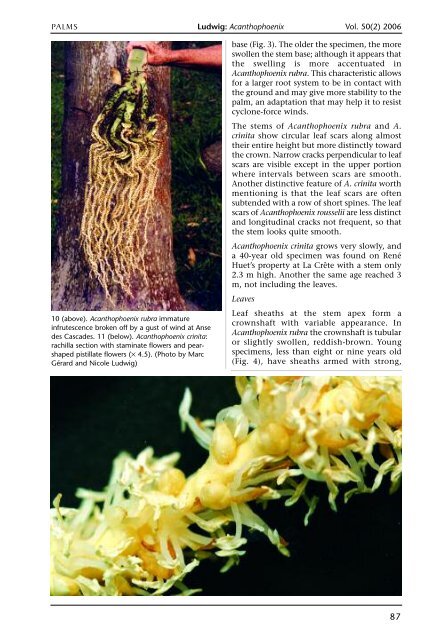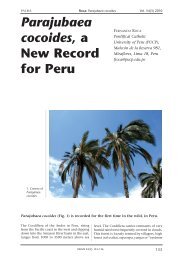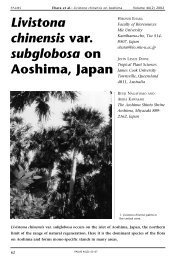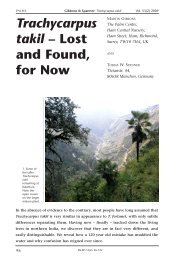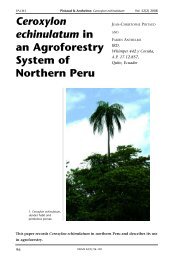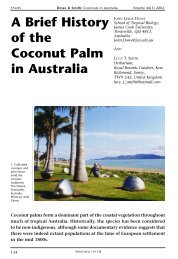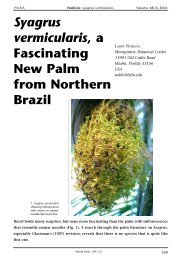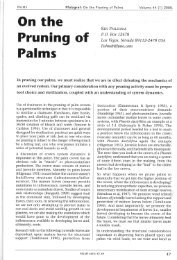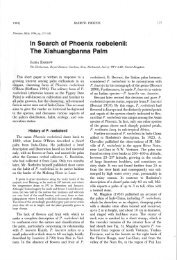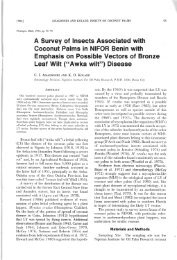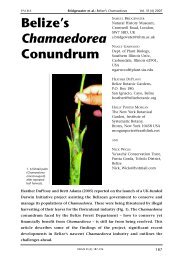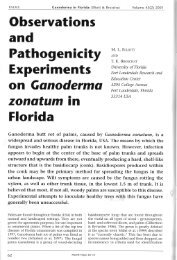Acanthophoenix crinita - International Palm Society
Acanthophoenix crinita - International Palm Society
Acanthophoenix crinita - International Palm Society
You also want an ePaper? Increase the reach of your titles
YUMPU automatically turns print PDFs into web optimized ePapers that Google loves.
PALMS Ludwig: <strong>Acanthophoenix</strong> Vol. 50(2) 2006<br />
10 (above). <strong>Acanthophoenix</strong> rubra immature<br />
infrutescence broken off by a gust of wind at Anse<br />
des Cascades. 11 (below). <strong>Acanthophoenix</strong> <strong>crinita</strong>:<br />
rachilla section with staminate flowers and pearshaped<br />
pistillate flowers (× 4.5). (Photo by Marc<br />
Gérard and Nicole Ludwig)<br />
base (Fig. 3). The older the specimen, the more<br />
swollen the stem base; although it appears that<br />
the swelling is more accentuated in<br />
<strong>Acanthophoenix</strong> rubra. This characteristic allows<br />
for a larger root system to be in contact with<br />
the ground and may give more stability to the<br />
palm, an adaptation that may help it to resist<br />
cyclone-force winds.<br />
The stems of <strong>Acanthophoenix</strong> rubra and A.<br />
<strong>crinita</strong> show circular leaf scars along almost<br />
their entire height but more distinctly toward<br />
the crown. Narrow cracks perpendicular to leaf<br />
scars are visible except in the upper portion<br />
where intervals between scars are smooth.<br />
Another distinctive feature of A. <strong>crinita</strong> worth<br />
mentioning is that the leaf scars are often<br />
subtended with a row of short spines. The leaf<br />
scars of <strong>Acanthophoenix</strong> rousselii are less distinct<br />
and longitudinal cracks not frequent, so that<br />
the stem looks quite smooth.<br />
<strong>Acanthophoenix</strong> <strong>crinita</strong> grows very slowly, and<br />
a 40-year old specimen was found on René<br />
Huet’s property at La Crête with a stem only<br />
2.3 m high. Another the same age reached 3<br />
m, not including the leaves.<br />
Leaves<br />
Leaf sheaths at the stem apex form a<br />
crownshaft with variable appearance. In<br />
<strong>Acanthophoenix</strong> rubra the crownshaft is tubular<br />
or slightly swollen, reddish-brown. Young<br />
specimens, less than eight or nine years old<br />
(Fig. 4), have sheaths armed with strong,<br />
87


